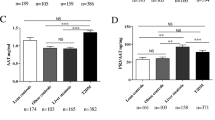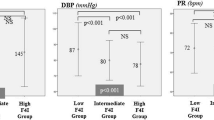Abstract
Aim: this study was conducted to demonstrate the plasminogen activator inhibitor-1 (PAI-1) and thrombin activatable fibrinolysis inhibitor antigen (TAFI-Ag) levels in non-alcoholic steatohepatitis (NASH). Materials and methods: Twenty-seven patients with biopsy-proven NASH and 18 healthy controls (HC) were recruited for the study. Anthropometric data, liver histology (no.=20) and laboratory parameters including PAI-1 and TAFI-Ag assessments were recorded. Results: When compared with HC, patients with NASH had higher body weight, higher waist circumference, elevated blood pressure, higher fasting plasma glucose (FPG) levels and higher homeostasis model assessment (HOMA) scores. the mean plasma PAI-1 levels of patients was found to be higher than HC (87.60 ng/ml vs 30.84 ng/ml p=0.000) and mean plasma TAFI-Ag levels of patients was found to be significantly lower (8.69 μg/ml vs 12.19 μg/ml p=0.000). PAI-1 levels were correlated with systolic blood pressure, age, body weight, transaminases, waist circumference, FPG, body mass index, and HOMA score. TAFI-Ag levels were found to be negatively correlated with transaminases, waist circumference, and body weight. In multiple regression analysis, BMI was the independent variable effecting PAI-1 levels. We did not show any association between PAI-1, TAFI-Ag, disease activity score and fibrosis score. HOMA was the independent variable effecting liver fibrosis in our patients. Conclusion: In this study we demonstrated that patients with biopsy-proven NASH had higher PAI-1 and lower TAFI-Ag expression than HC. Elevated levels of PAI-1 in NASH is the consequence of insulin resistance state. Lower TAFI-Ag levels may be related to the overactivation of TAFI pathway resulting in TAFI-Ag depletion. Furthermore, liver function disturbances may impair TAFI production in NASH. We also showed that NASH patients even with slight elevations of transaminases feature marked insulin resistance and components of metabolic syndrome.
Similar content being viewed by others
References
Dixon JB, Bhathal PS, O’Brien PE. Nonalcoholic fatty liver disease: predictors of nonalcoholic steatohepatitis and liver fibrosis in the severely obese. Gastroenterology 2001, 121: 91–100.
Garcia-Monzon C, Martin-Perez E, Iacono OL, et al. Characterization of pathogenic and prognostic factors of nonalcoholic steatohepatitis associated with obesity. J Hepatol 2000, 33: 716–24.
Wanless IR, Lentz JS. Fatty liver hepatitis (steatohepatitis) and obesity: an autopsy study with analysis of risk factors. Hepatology 1990, 12: 1106–10.
Medina J, Fernández-Salazar LI, García-Buey L, Moreno-Otero R. Approach to the pathogenesis and treatment of non-alcoholic steatohepatitis. Diabetes Care 2004, 27: 2057–66.
Targher G, Bertolini L, Padovani R, et al. Increased prevalence of cardiovascular disease in Type 2 diabetic patients with non-alcoholic fatty liver disease. Diabet Med 2006, 23: 403–9.
Utzschneider KM, Kahn SE. The Role of Insulin Resistance in Non-alcoholic Fatty Liver Disease. J Clin Endocrinol Metab 2006, 91: 4753–61.
Targher G, Bertolini L, Padovani R, et al. Non-alcoholic fatty liver disease is associated with carotid artery wall thickness in diet-controlled type 2 diabetic patients. J Endocrinol Invest 2006, 29: 55–60.
Targher G, Bertolini L, Padovani R, et al. Relations between carotid artery wall thickness and liver histology in subjects with nonalcoholic fatty liver disease. Diabetes Care 2006, 29: 1325–30.
Vaughan DE. PAI-1 and atherothrombosis. J Thromb Haemost 2005, 3: 1879–83.
Juhan-Vague I, Alessi MC, Mavri A, Morange PE. Plasminogen activator inhibitor-1, inflammation, obesity, insulin resistance and vascular risk. J Thromb Haemost 2003, 1: 1575–9.
Kitagawa N, Yano Y, Gabazza EC, et al. Different metabolic correlations of thrombin-activatable fibrinolysis inhibitor and plasminogen activator inhibitor-1 in non-obese type 2 diabetic patients. Diabetes Res Clin Pract 2006, 73: 150–7.
Emeis JJ, Kooistra T. Interleukin 1 and lipopolysaccharide induce an inhibitor of tissue-type plasminogen activator in vivo and in cultured endothelial cells. J Exp Med 1986, 163: 1260–6.
Sawdey M, Podor TJ, Loskutoff DJ. Regulation of type 1 plasminogen activator inhibitor gene expression in cultured bovine aortic endothelial cells. Induction by transforming growth factor-beta, lipopolysaccharide, and tumor necrosis factor-alpha. J Biol Chem 1989, 264: 10396–401.
Alessi MC, Juhan-Vague I. PAI-1 and the metabolic syndrome: links, causes, and consequences. Arterioscler Thromb Vasc Biol 2006, 26: 2200–7.
Wang W, Boffa MB, Bajzar L, Walker JB, Nesheim ME. A study of the mechanism of inhibition of fibrinolysis by activated thrombin-activable fibrinolysis inhibitor. J Biol Chem 1998, 273: 27176–81.
Bajzar L, Manuel R, Nesheim ME. Purification and characterization of TAFI, a thrombin-activable fibrinolysis inhibitor. J Biol Chem 1995, 270: 14477–84.
Yano Y, Kitagawa N, Gabazza EC, et al. Increased plasma thrombin-activatable fibrinolysis inhibitor levels in normotensive type 2 diabetic patients with microalbuminuria. J Clin Endocrinol Metab 2003, 8: 736–41.
Aubert H, Frère C, Aillaud MF, Morange PE, Juhan-Vague I, Alessi MC. Weak and non-independent association between plasma TAFI antigen levels and the insulin resistance syndrome. J Thromb Haemost 2003, 1: 791–7.
Kleiner DE, Brunt EM, Van Natta M, et al. Design and validation of a histological scoring system for nonalcoholic fatty liver disease. Hepatology 2005, 41: 1313–21.
Bonora E, Targher G, Alberiche M, et al. Homeostasis model assessment closely mirrors the glucose clamp technique in the assessment of insulin sensitivity: studies in subjects with various degrees of glucose tolerance and insulin sensitivity. Diabetes Care 2000, 23: 57–63.
Day CP. Pathogenesis of steatohepatitis. Best Pract Res Clin Gastroenterol 2002, 16: 663–78.
Juhan-Vague I, Morange PE, Alessi MC. The insulin resistance syndrome: implications for thrombosis and cardiovascular disease. Pathophysiol Haemost Thromb 2002, 32: 269–73.
Bruckert E, Ankri A, Giral P, Turpin G. Relation between plasminogen activator inhibitor-1 and hepatic enzyme concentrations in hyperlipidemic patients. Thromb Haemost 1994, 72: 434–7.
Cigolini M, Targher G, Agostino G, Tonoli M, Muggeo M, De Sandre G. Liver steatosis and its relation to plasma haemostatic factors in apparently healthy men—role of the metabolic syndrome. Thromb Haemost 1996, 76: 69–73.
Ishii M, Yoshioka Y, Ishida W, et al. Liver fat content measured by magnetic resonance spectroscopy at 3.0 tesla independently correlates with plasminogen activator inhibitor-1 and body mass index in type 2 diabetic subjects. Tohoku J Exp Med 2005, 206: 23–30.
TargherG, Bertolini L, Scala L, Zoppini G, Zenari L, Falezza G. Non-alcoholic hepatic steatosis and its relation to increased plasma biomarkers of inflammation and endothelial dysfunction in non-diabetic men. Role of visceral adipose tissue. Diabet Med 2005, 22: 1354–8.
Hori Y, Gabazza EC, Yano Y, et al. Insulin resistance is associated with increased circulating level of thrombin-activatable fibrinolysis inhibitor in type 2 diabetic patients. J Clin Endocrinol Metab 2002, 87: 660–5.
Aso Y, Wakabayashi S, Yamamoto R, Matsutomo R, Takebayashi K, Inukai T. Metabolic syndrome accompanied by hypercholesterolemia is strongly associated with proinflammatory state and impairment of fibrinolysis in patients with type 2 diabetes: synergistic effects of plasminogen activator inhibitor-1 and thrombin-activatable fibrinolysis inhibitor. Diabetes Care 2005, 28: 2211–6.
Eaton DL, Malloy BE, Tsai SP, Henzel W, Drayna D. Isolation, molecular cloning, and partial characterization of a novel carboxypeptidase B from human plasma. J Biol Chem 1991, 266: 21833–8.
Colucci M, Binetti BM, Branca MG, et al. Deficiency of thrombin activatable fibrinolysis inhibitor in cirrhosis is associated with increased plasma fibrinolysis. Hepatology 2003, 38: 230–7.
Lisman T, Leebeek FW, Mosnier LO, et al. Thrombin-activatable fibrinolysis inhibitor deficiency in cirrhosis is not associated with increased plasma fibrinolysis. Gastroenterology 2001, 121: 131–9.
Van Thiel DH, George M, Fareed J. Low levels of thrombin activatable fibrinolysis inhibitor (TAFI) in patients with chronic liver disease. Thromb Haemost 2001, 85: 667–70.
Zeerleder S, Schroeder V, Hack CE, Kohler HP, Wuillemin WA. TAFI and PAI-1 levels in human sepsis. Thromb Res 2006, 118: 205–12.
Author information
Authors and Affiliations
Corresponding author
Rights and permissions
About this article
Cite this article
Yener, S., Akarsu, M., Demir, T. et al. Plasminogen activator inhibitor-1 and thrombin activatable fibrinolysis inhibitor levels in non-alcoholic steatohepatitis. J Endocrinol Invest 30, 810–819 (2007). https://doi.org/10.1007/BF03349221
Accepted:
Published:
Issue Date:
DOI: https://doi.org/10.1007/BF03349221




